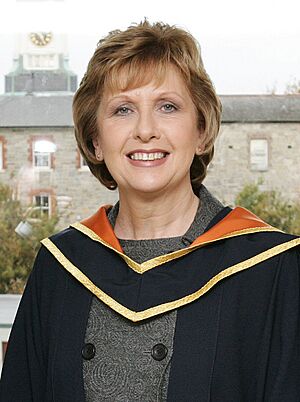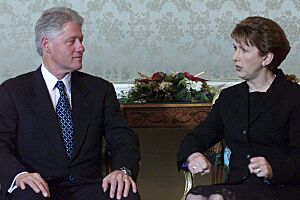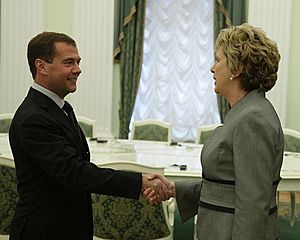Mary McAleese facts for kids
Quick facts for kids
Mary McAleese
|
|
|---|---|

McAleese in 2007
|
|
| President of Ireland | |
| In office 11 November 1997 – 11 November 2011 |
|
| Taoiseach | |
| Preceded by | Mary Robinson |
| Succeeded by | Michael D. Higgins |
| Personal details | |
| Born |
Mary Patricia Leneghan
27 June 1951 Belfast, Northern Ireland |
| Political party | Independent (since 1997) |
| Other political affiliations |
Fianna Fáil (before 1997) |
| Spouse |
Martin McAleese
(m. 1976) |
| Children | 3 |
| Alma mater |
|
| Profession | |
| Signature |  |
Mary Patricia McAleese, born on 27 June 1951, is an Irish lawyer, writer, and former politician. She served as the President of Ireland from November 1997 to November 2011. She was the second woman to become President of Ireland, following Mary Robinson. She was also the first woman in the world to be succeeded by another woman as president.
McAleese was first elected president in 1997. She was re-elected for a second term in 2004 without anyone running against her. She was the first President of Ireland to come from Northern Ireland.
She studied law at Queen's University Belfast. Later, she became a professor of law at Trinity College Dublin. She also worked as a journalist for RTÉ, Ireland's national broadcaster.
During her time as president, McAleese focused on bringing people together. She called her presidency's main goal "Building Bridges." This meant trying to connect with different communities, especially in Northern Ireland. She worked to promote fairness, equality, and understanding between people.
Contents
Early Life and Family
Mary Patricia Leneghan was born in Ardoyne, north Belfast. Her parents were Paddy Leneghan and Claire McManus. She grew up in a neighborhood that had many different religious backgrounds. Her family had to leave their home when a period of conflict, known as the Troubles, began.
She went to St Dominic's Grammar School for Girls, a Catholic school in Belfast. She then studied law at Queen's University Belfast, finishing in 1973. She became a lawyer in Northern Ireland in 1974 and later in the Republic of Ireland.
In 1976, she married Martin McAleese, who was an accountant and dentist. They have three children: Emma, Justin, and SaraMai. Her husband, Martin, helped her with some of her projects during her presidency.
Career Before Presidency
After working as a lawyer in Belfast for a year, McAleese became a professor of criminal law at Trinity College Dublin in 1975. She took over this role from Mary Robinson.
She also became a legal advisor and a founding member of a group that worked to change laws to be fairer for all people. In 1979, she joined RTÉ as a journalist and presenter. She later returned to her professorship but continued to work part-time for RTÉ.
In 1987, she went back to Queen's University Belfast to lead the Institute of Professional Legal Studies. She also became the first female Pro-Vice-Chancellor of Queen's University in 1994.
McAleese has always been interested in bringing different groups together and fighting against division. She helped lead a group that studied division in Ireland and wrote a report about it. She also hosted a radio series called "The Protestant Mind" on BBC Radio Ulster, which encouraged people from different backgrounds to understand each other better.
Her Time as President
First Term (1997–2004)

In 1997, Mary McAleese was chosen by the Fianna Fáil party to run for president. She won the election against other candidates, including Mary Banotti and Adi Roche. On 11 November 1997, she became the eighth President of Ireland. Soon after, she made her first official trip abroad to Lebanon.
President McAleese's main goal was "building bridges." As the first president from Northern Ireland, she visited the region often. She was usually welcomed by everyone, even though some people thought she might cause division. People from all over Ulster often visited her official residence, Áras an Uachtaráin.
She also showed respect for different traditions. For example, she said she would celebrate the Twelfth of July, which is important to many Protestants in Ulster, as well as Saint Patrick's Day. She also attended a service in a Church of Ireland cathedral in Dublin, which showed her commitment to connecting different faiths.
Second Term (2004–2011)
McAleese's first seven-year term ended in November 2004. She decided to run for a second term. Because no other candidates received enough support to run against her, she was re-elected without opposition on 1 October 2004. She began her second term on 11 November 2004. Her high popularity was a big reason why no one ran against her.
In 2005, she attended a ceremony remembering the liberation of Auschwitz concentration camp. She later apologized for comments she made about how some children in Northern Ireland were taught to dislike Catholics, saying her remarks were not balanced.
She visited Hollywood in 2008 to promote the Irish film and television industry. In 2009, Forbes magazine named her among the hundred most powerful women in the world.
In 2010, she visited New York City. She spoke to business leaders about the Irish banking crisis and opened an exhibition about the Great Famine. She also gave a speech at Fordham University.
In March 2011, President McAleese invited Queen Elizabeth II to visit Ireland. The Queen accepted, and the visit took place in May 2011. This was the first state visit by a British monarch since Ireland became independent. This event was seen as a very important and successful step in improving relations between the two countries.
Mary McAleese made her last official trip abroad as president to Lebanon in October 2011, which was also the location of her first overseas visit in 1997. She left office on 10 November 2011, and Michael D. Higgins became the new president. On her last day, she thanked Ireland for her two terms in an article in The Irish Times.
After the Presidency
Returning Funds and Awards
In May 2012, it was reported that Mary McAleese had voluntarily returned over €500,000 in unused funds from her presidential allowance. She also gave most of the gifts she received during her 14 years in office to the Irish state and to Gaisce – The President's Award, a national youth award.
In January 2012, Mary McAleese and her husband Martin were given the Tipperary Peace Prize for their work.
Further Studies and Appointments
McAleese continued her studies and earned a doctorate in Catholic canon law in 2018 from the Pontifical Gregorian University. She had become interested in this area due to concerns about challenges within the Church.
Since leaving office, McAleese has taken on many important roles. In 2012, she became the Chair of a European Commission group focused on improving higher education in the European Union. In 2013, she was appointed Chair of the Von Hugel Institute at the University of Cambridge.
She has also been a visiting professor at several universities, including Boston College, St Mary's University, Twickenham, and the University of Notre Dame. In 2017, she was appointed a Canon of the Church of Ireland's Christ Church Cathedral, Dublin. In 2018, she became a Professor of Children, Law and Religion at the University of Glasgow.
In November 2019, McAleese was elected as the Chancellor of Trinity College Dublin, a very important role at one of Ireland's oldest universities.
Podcast Host
In 2024, Mary McAleese started hosting a podcast called "Changing Times - The Allenwood Conversations" with broadcaster Mary Kennedy.
Views on the Catholic Church
Mary McAleese has spoken openly about her views on the Catholic Church, especially regarding the role of women and children's rights. She believes that women should have a greater voice and be included in all decision-making within the Church. She has said that the Church's leadership needs to find ways to include women's voices, especially since women are not allowed to be priests.
She has also called for the Catholic Church to recognize that its own laws should align with international agreements on children's rights, such as the UN Convention on the Rights of the Child.
In 2018, McAleese was scheduled to speak at a conference in the Vatican about women in the Church. However, she was prevented from speaking there by a Cardinal. In response, the conference organizers moved the event to a different location nearby, and McAleese delivered her speech there.
Advocacy for Equality
Background and Early Work
Mary McAleese has a long history of advocating for equality for all people. In 1975, she helped start a group that worked to make laws fairer for everyone, including LGBTQ+ individuals. She became aware of the challenges faced by gay people when she was a student and decided to work towards positive change in Ireland.
During and After Presidency
During her presidency, McAleese continued to speak out for equality. In 2008, she encouraged young people to stand up against unfair comments about gay people, stating that being gay is "not a choice but a discovery." In 2010, she said that negative attitudes towards LGBTQ+ people cause great suffering and have no place in the Ireland we are building.
In 2011, she declined an invitation to be the Grand Marshal at the New York City St. Patrick's Day parade because LGBTQ+ people were not allowed to march under their own banners.
McAleese has also expressed concern about the number of young men, especially young gay men, who take their own lives in Ireland. She believes that negative messages about homosexuality can cause great internal conflict for young people.
Marriage Equality
In May 2015, before the vote on marriage equality in Ireland, McAleese and her husband, Martin, publicly supported a "Yes" vote. She described same-sex marriage as a "human rights issue" and said that passing the referendum would help break down unfair attitudes. She emphasized that the vote was about "Ireland's children, gay children" and ensuring they could live full lives.
In June 2018, McAleese attended the Dublin Pride parade for the first time with her husband, son Justin, and his husband. She spoke at the parade, saying that unfair treatment "ruins people's lives" and "has caused people to live in dark shadows."
For her work, McAleese has received several awards recognizing her commitment to equal treatment and dignity for LGBTQ+ people.
Brexit Views
In June 2016, Mary McAleese urged people in the United Kingdom to vote to remain in the European Union (EU). She warned that Britain leaving the EU, known as Brexit, could lead to new border controls between Northern Ireland and the Republic of Ireland. She also worried it could affect the peace process in Northern Ireland.
She explained that many border checks had been removed because of EU laws, not just agreements between Ireland and the UK. She believed that if Britain left the EU, these checks might return. She also thought that eventually, people might need ID cards to cross the border.
In March 2019, McAleese spoke about Brexit again, saying it had caused a lot of wasted time, effort, and anxiety. She expressed sadness that the UK was leaving the EU, which she called "the greatest and the noblest political undertaking ever envisaged and realised in human history."
Honours and Awards
Honours
 France: Dignité de Grand Officier de l'Ordre National du Mérite – 2019
France: Dignité de Grand Officier de l'Ordre National du Mérite – 2019
Freedom of the Burgh
 Kilkenny – 19 May 2009
Kilkenny – 19 May 2009
Dynastic orders
 Dame Grand Cross of the Two Sicilian Royal Sacred Military Constantinian Order of Saint George, Special Class
Dame Grand Cross of the Two Sicilian Royal Sacred Military Constantinian Order of Saint George, Special Class
Honorary Doctorates, Degrees and Fellowships
 Member of the Royal Irish Academy – 1998
Member of the Royal Irish Academy – 1998 Honorary Degree from the Harbin Institute of Technology – 2003
Honorary Degree from the Harbin Institute of Technology – 2003 Honorary Fellowship of the Royal Colleges of Surgeons – 2006
Honorary Fellowship of the Royal Colleges of Surgeons – 2006 Honorary Doctorate of Laws from the University of Otago – 31 October 2007
Honorary Doctorate of Laws from the University of Otago – 31 October 2007 Honorary Doctorate of Law from the Mount Holyoke College – 24 May 2009
Honorary Doctorate of Law from the Mount Holyoke College – 24 May 2009 Honorary Doctorate of Law from the Fordham University – 22 May 2010
Honorary Doctorate of Law from the Fordham University – 22 May 2010 Honorary Fellow of the Royal Society of Edinburgh – 2012
Honorary Fellow of the Royal Society of Edinburgh – 2012 Honorary doctorate at UMass Lowell – 8 November 2013
Honorary doctorate at UMass Lowell – 8 November 2013 Honorary Fellow of the Learned Society of Wales – 2017
Honorary Fellow of the Learned Society of Wales – 2017 Honorary Member of the Society of Legal Scholars
Honorary Member of the Society of Legal Scholars
Awards
 The Silver World Award of the Boy Scouts of America - March 1998
The Silver World Award of the Boy Scouts of America - March 1998 The American Ireland Fund Humanitarian Award – 3 May 2007
The American Ireland Fund Humanitarian Award – 3 May 2007 Blessed are the Peacemakers Award from Catholic Theological Union – 17 April 2013
Blessed are the Peacemakers Award from Catholic Theological Union – 17 April 2013 Alfons Auer Ethics Award – 2019
Alfons Auer Ethics Award – 2019
Other Honours and Awards
On 8 June 2013, a bridge on the M1 motorway near Drogheda was renamed the Mary McAleese Boyne Valley Bridge. This was done to honor her important work in the Northern Ireland peace process.
Images for kids
See also
 In Spanish: Mary McAleese para niños
In Spanish: Mary McAleese para niños



